This morning we heard one of the most famous passages in the Bible, Isaiah chapter 11, a passage often called the “Peaceable Kingdom.” In this passage the prophet envisions a peaceful, harmonious world where animals that are normally predator and prey lay down with each other in a world where their former natures have been transformed into a new life-giving reality. Isaiah chapter 11 has been the subject of many artistic interpretations throughout the centuries. One of the most well-known depictions is by the Quaker painter Edward Hicks in the early 19th century. 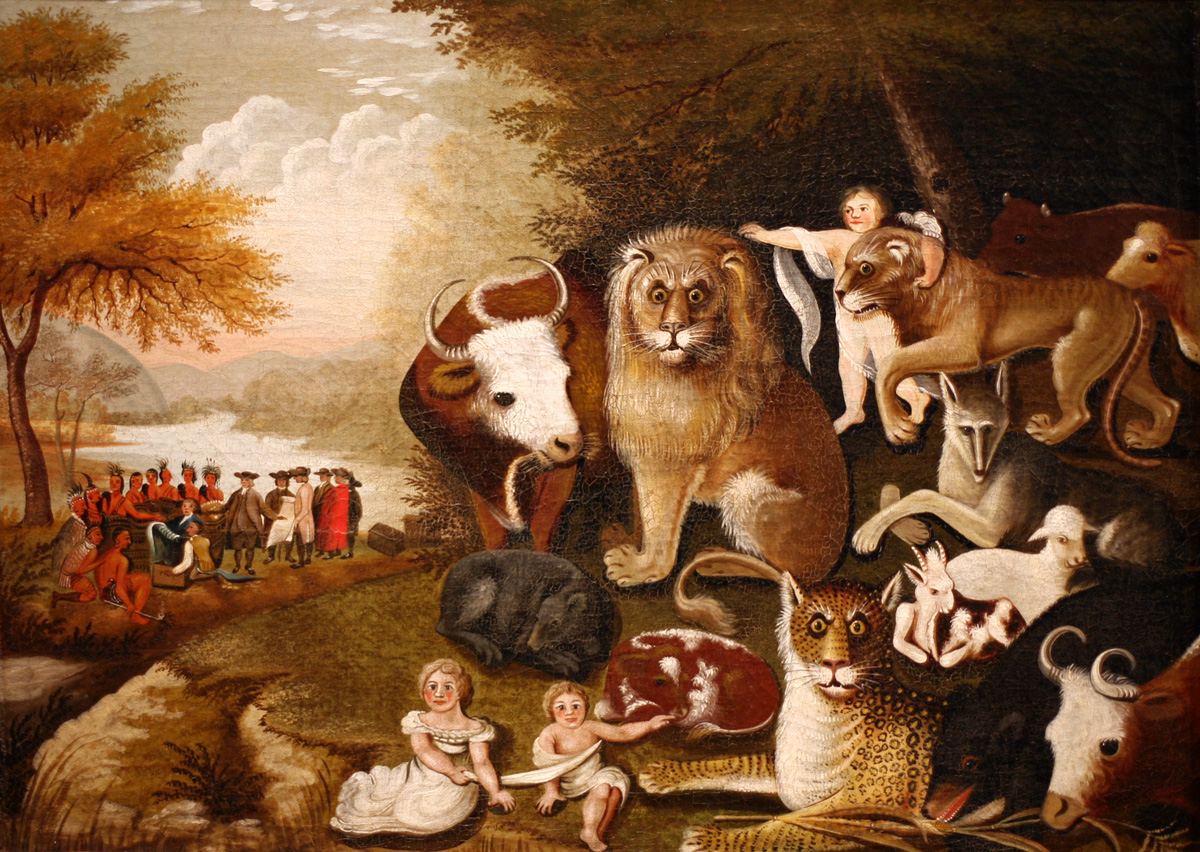 He depicted children in intimate repose with the transformed animals while off in the distance by the river is William Penn making his treaty with the Native peoples. In one version of the painting called “The Peaceable Kingdom and Penn’s Treaty,” Hicks portrayed Penn, according to one art historian, as carrying a “flowing banner inscribed with lines from the book of Luke telling of the coming of the messiah.”
He depicted children in intimate repose with the transformed animals while off in the distance by the river is William Penn making his treaty with the Native peoples. In one version of the painting called “The Peaceable Kingdom and Penn’s Treaty,” Hicks portrayed Penn, according to one art historian, as carrying a “flowing banner inscribed with lines from the book of Luke telling of the coming of the messiah.”
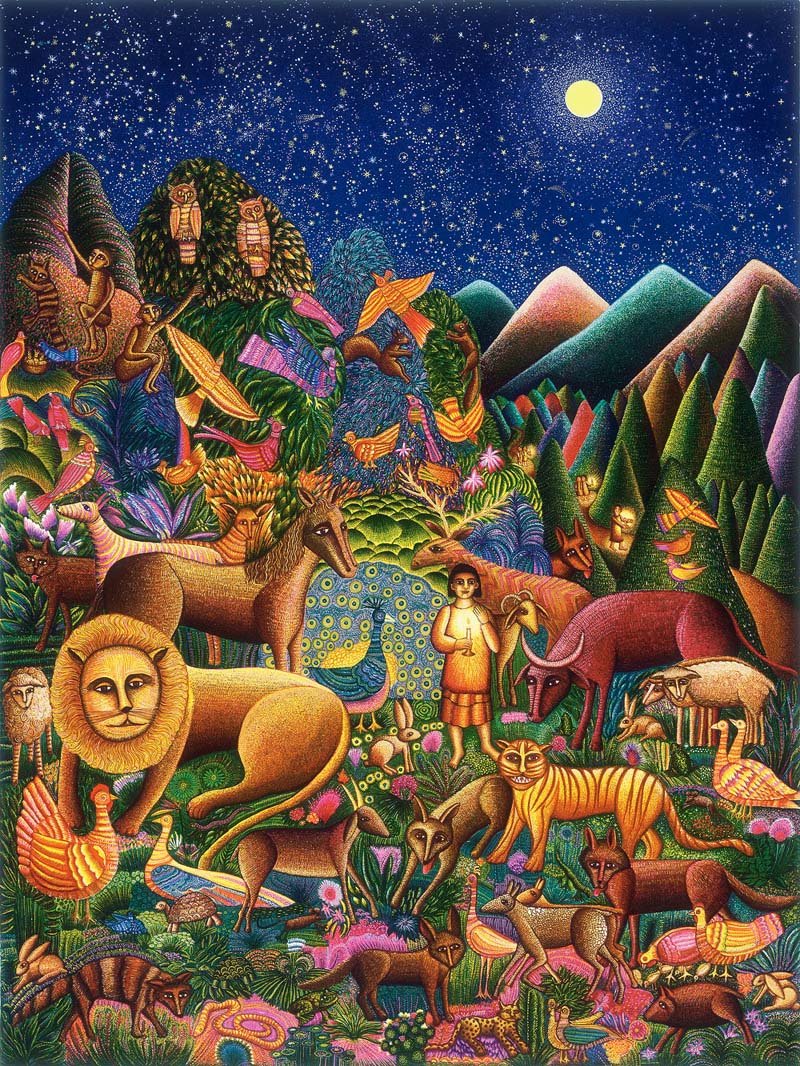 In the representation of American artist John August Swanson, he included a broad and diverse array of animals—many more species than are mentioned in Isaiah chapter 11—in his trademark style that he describes as “influenced by the imagery of Islamic and medieval miniatures, Russian iconography, the color of Latin American folk art, and the tradition of Mexican muralists.” What I find particularly inspiring about John August Swanson’s version are the people making their way up a trail meandering through the mountains, holding candles on their way up to the peaceable kingdom, which has Isaiah’s child in the center holding his or her own candle.
In the representation of American artist John August Swanson, he included a broad and diverse array of animals—many more species than are mentioned in Isaiah chapter 11—in his trademark style that he describes as “influenced by the imagery of Islamic and medieval miniatures, Russian iconography, the color of Latin American folk art, and the tradition of Mexican muralists.” What I find particularly inspiring about John August Swanson’s version are the people making their way up a trail meandering through the mountains, holding candles on their way up to the peaceable kingdom, which has Isaiah’s child in the center holding his or her own candle.
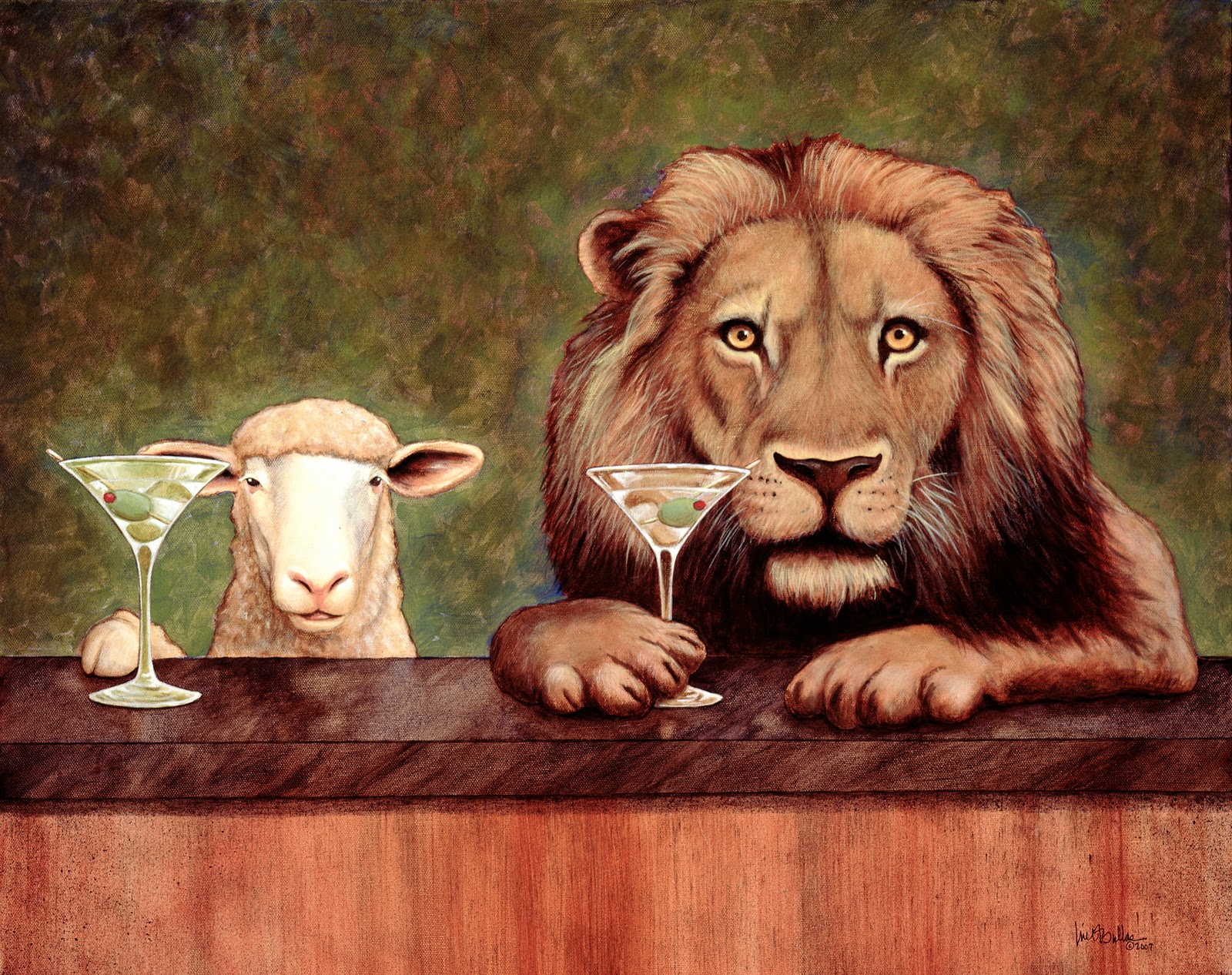 Master watercolor artist Will Bullas who, in his words, “makes fine art fun,” plays on the Isaiah 11 motif by portraying the lion and the lamb sitting at a bar together drinking martinis in his painting titled, “Peaceable Kingdom with Two Olives.”
Master watercolor artist Will Bullas who, in his words, “makes fine art fun,” plays on the Isaiah 11 motif by portraying the lion and the lamb sitting at a bar together drinking martinis in his painting titled, “Peaceable Kingdom with Two Olives.”
And last but not least, we have the artwork of our five-year-old son Tim Walters in our living room. After arranging his VeggieTales Nativity, Tim laid down his precious plastic snakes he bought in Yosemite Valley this summer on vacation by facing them around the baby Jesus, his family, and their visiting entourage. 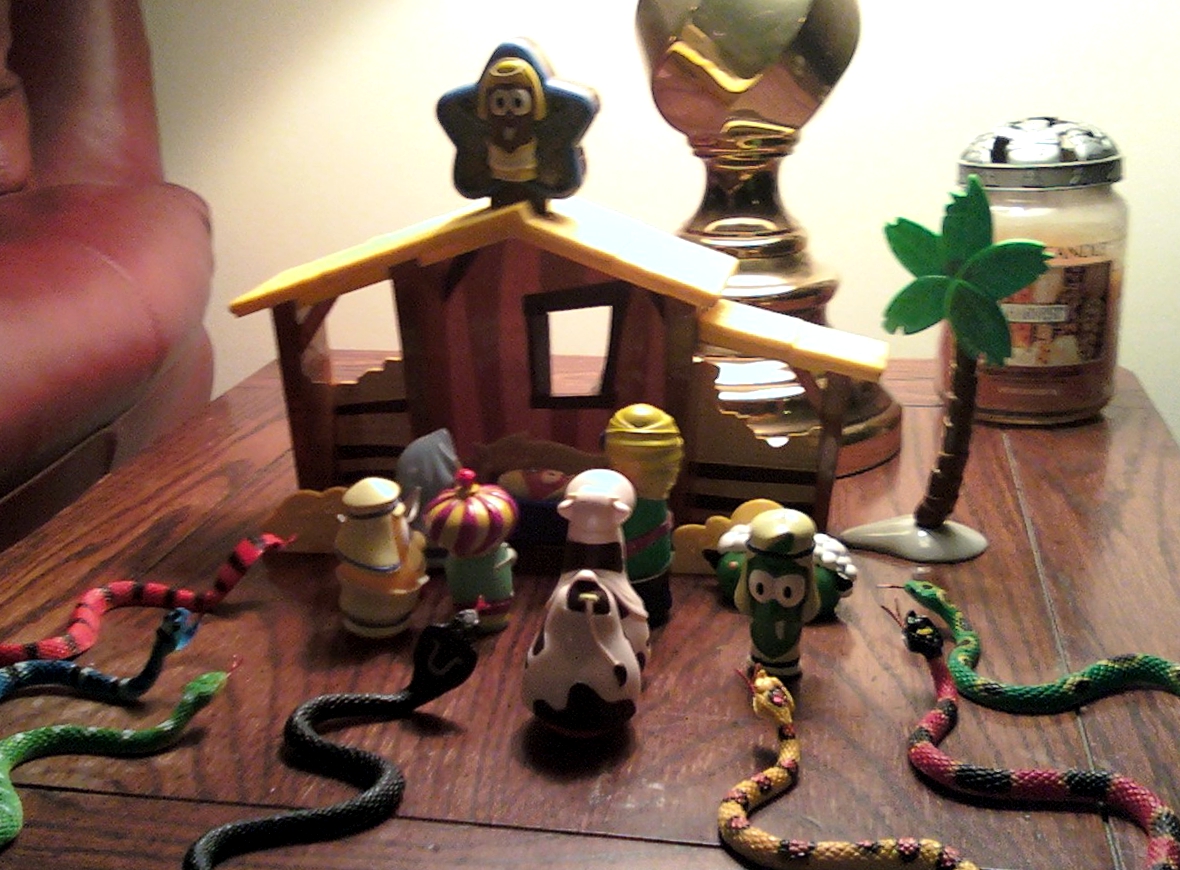 Tim inadvertently suggests—with some imagination—that we can see the crushing of the serpent’s head in Genesis 3:15 transformed into the child nursing where poisonous snakes live in Isaiah 11:8.
Tim inadvertently suggests—with some imagination—that we can see the crushing of the serpent’s head in Genesis 3:15 transformed into the child nursing where poisonous snakes live in Isaiah 11:8.
All of these works of art interpret Isaiah 11 through their own unique inspiration and imagination. Isaiah 11 is the culmination of human hope for a transformed world, a world when and where, in the words of John in Revelation 21, “Death will be no more; mourning and crying and pain will be no more, for the first things have passed away.” This is the inauguration of the transformed world that we celebrate in the birth of Christ, God’s redeemer, on the day of Christmas. But I get ahead of myself. We are currently in the season of Advent. This is the season we wait expectantly for the transformed world. And this is the season that we hope… for many different things and desires of our heart to be fulfilled. Our hope is not grounded, however, in the comfort of familiar yearly patterns of consumerist preparation for the “holidays” with Black Friday and Cyber Monday as our starting points. Our hope is grounded in the transformed reality of Isaiah 11, a reality that is yet future but is also past and present, especially in the birth, work, death, and resurrection of Jesus … and his followers … and in us. Without the visions and missions, sacrifices and interpretations of all the believers that have gone before us for millennia, our aspirations for and imagination of God’s peaceable kingdom would be greatly impoverished, if not impossible. This realization and appreciation is what the apostle Paul was getting at in his letter to the bands of Christians in Rome that we just heard spoken here among us: “For whatever was written in former days was written for our instruction, so that by steadfastness and by the encouragement of the scriptures we might have hope.” It is fitting that Paul, in culminating his argument in chapters 14 and 15 and, indeed, of the whole of Romans, recalls the words of Isaiah 11:10, “The root of Jesse shall come, the one who rises to rule the Gentiles; in him the Gentiles shall hope.” The “root of Jesse,” of course, is a direct allusion in Christian terms to Jesus.
Christian faith, whether it is weak or strong—as Paul wrote in Romans before the text we heard this morning—is rooted in history, in the historical unfolding of God’s transforming and perfecting grace in creation. “Faith” in Christ is not simply mutual consent that “Christians” do certain things or eat certain foods or worship in certain ways, in contrast to people who are not “Christians.” Paul wrote in Romans 14:17, “For the kingdom of God is not food and drink but righteousness and peace and joy in the Holy Spirit.” Christian peace and joy are rooted in the hope for an Isaiah 11 transformation of the world, and the scriptures testify to that transformation through which “we might have hope” so that we may “live in harmony with one another, in accordance with Christ Jesus.”
The artwork of Edward Hicks and John August Swanson with their unique technique and the playful art of Will Bullas and even Tim Walters can intrigue and inspire us to appreciate their visions and interpretations of Isaiah 11. But if we do not imagine for ourselves how we may contribute to the building up of the peaceable kingdom and then persistently act upon our hopeful imagination in that kingdom, then we do not have hope at all. True hope cannot be experienced vicariously or attained through a vision. I suppose it is possible for the awesome hope of another to create in us feelings of joy and peace and, perhaps, even feelings of faith, but unless we generate within ourselves the Isaiah 11 hope for a radically transformed world, then we will be chronically disappointed in the world as it is and further delay the realization of the future reality of Isaiah’s harmony by not participating with each other in ways that encourage a “spirit of wisdom and understanding, the spirit of counsel and might, the spirit of knowledge and the fear of the Lord justice,” in the words of Isaiah. “His delight shall be in the fear of the Lord. He shall not judge by what his eyes see, or decide by what his ears hear; but with righteousness he shall judge the poor, and decide with equity for the meek of the earth.”
I started by showing you some artistic depictions of Isaiah Chapter 11 and the peaceable kingdom. In conclusion I would like to introduce you to one more artist that I recently discovered in a brief mention in Leadership Journal and that I think had a strong vision of Isaiah’s peaceable kingdom. 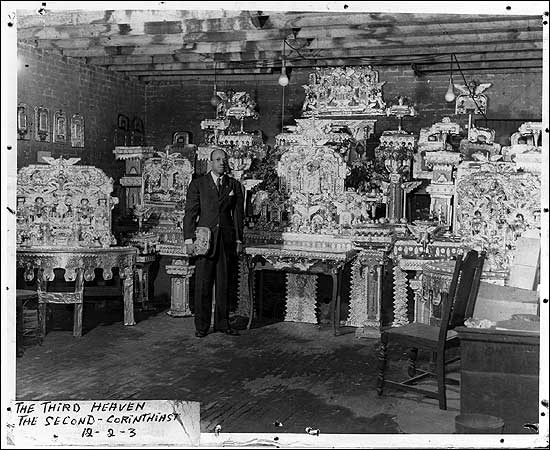 He is James Hampton of South Carolina. Mr. Hampton’s artwork is displayed in the Smithsonian American Art Museum. Despite this recognition, Mr. Hampton was almost completely unknown by anyone as an artist while he was alive as he lived an isolated life likely fraught with mental illness. He left home at age 19, joined the military during World War II, and then worked as a janitor for the government in Washington D.C. for many years upon exiting military service. Every night after work for years and years he would enter a garage he rented in a D.C. neighborhood to work on what he called, “The Throne of the Third Heaven of the Nation’s Millennium General Assembly.”
He is James Hampton of South Carolina. Mr. Hampton’s artwork is displayed in the Smithsonian American Art Museum. Despite this recognition, Mr. Hampton was almost completely unknown by anyone as an artist while he was alive as he lived an isolated life likely fraught with mental illness. He left home at age 19, joined the military during World War II, and then worked as a janitor for the government in Washington D.C. for many years upon exiting military service. Every night after work for years and years he would enter a garage he rented in a D.C. neighborhood to work on what he called, “The Throne of the Third Heaven of the Nation’s Millennium General Assembly.” 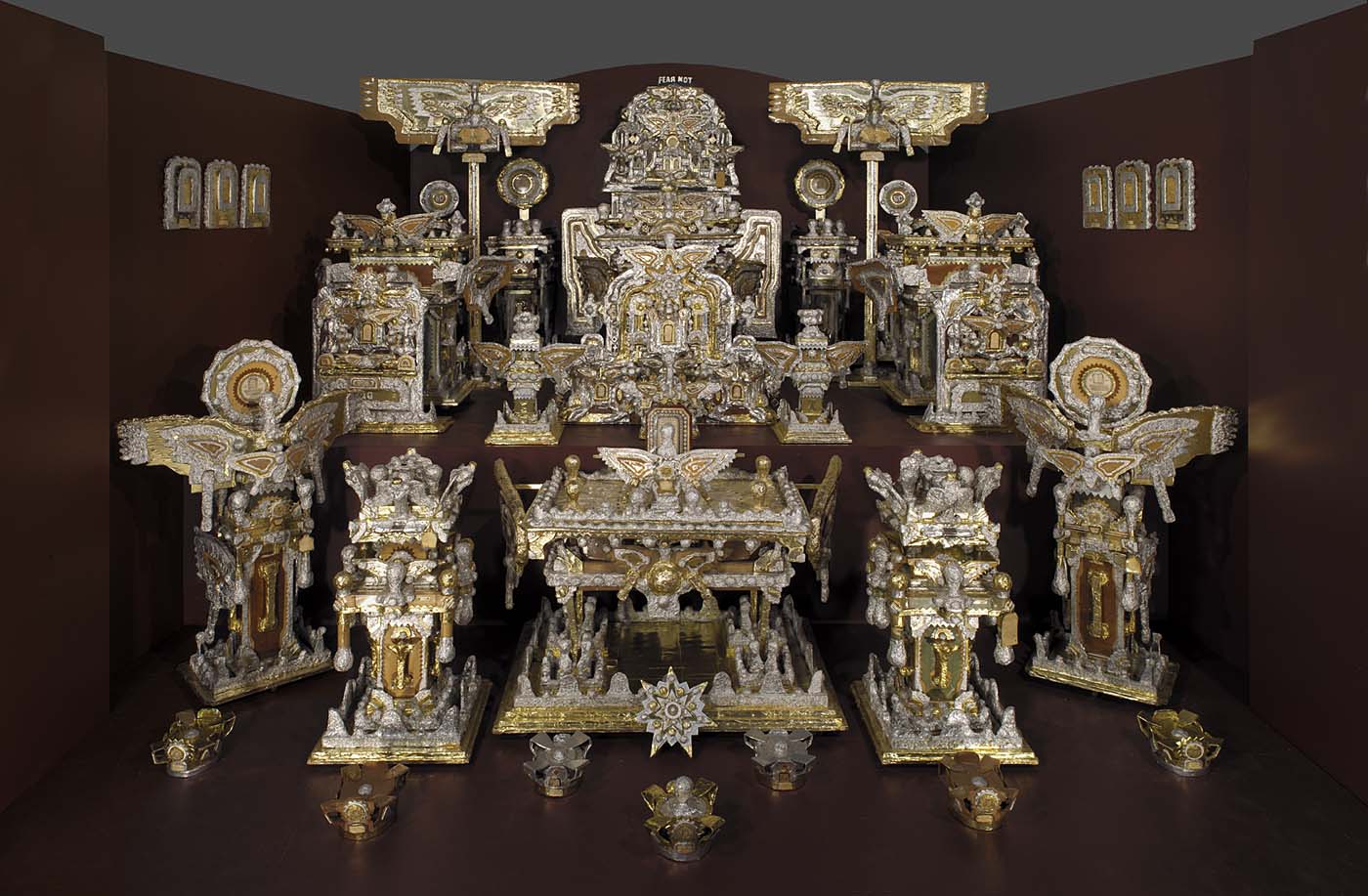 Inspired by personal religious visions and his obsession with the Bible’s apocalyptic material, such as Daniel and Revelation, Mr. Hampton created what is arguably one of the nation’s premier treasures of American folk art by transforming common consumables and garbage into his gold and silver masterpiece of God’s throne room. Lynda Roscoe Hartigan, Assistant Curator, wrote in 1976 of Mr. Hampton’s artwork:
Inspired by personal religious visions and his obsession with the Bible’s apocalyptic material, such as Daniel and Revelation, Mr. Hampton created what is arguably one of the nation’s premier treasures of American folk art by transforming common consumables and garbage into his gold and silver masterpiece of God’s throne room. Lynda Roscoe Hartigan, Assistant Curator, wrote in 1976 of Mr. Hampton’s artwork:
An ingenious selection and use of materials and an innate feeling for design characterize Hampton’s radiant work. A poor man, he applied his imagination to the transformation of discarded materials.
Merchants in the used-furniture district near the garage remember that Hampton would browse, inquire about prices, and sometimes return with a child’s wagon to carry away his purchases. All of the objects are covered with different grades of gold and aluminum foils removed from store displays, bottles, cigarette boxes, and rolls of kitchen foil. Hampton paid neighborhood indigents for the foil on their wine bottles, and he walked the streets with a croker sack in which to carry his finds.
He also gathered used light bulbs, cardboard, insulation board, construction paper, desk blotters, and sheets of transparent plastic, probably from the trash of the government buildings where he worked.
An adage found on his bulletin board is telling: “Where There Is No Vision The People Perish.”
As with the vision of Isaiah 11 metaphorically transforming wild predators into playmates with domesticated animals and even children, Mr. Hampton’s artwork transforms materials many of us would casually see as waste, as the disposable products of exhausted lives and exhausting lifestyles.
Mr. Hampton was truly a man of vision, but I do not think I can call him a man of hope in the sense as I have expounded it this morning. Mr. Hampton’s artwork is a transformation, yes, and Mr. Hampton is the transformer. But it is unfortunate that Mr. Hampton was caught in the spiral of self and subjectivity. He was almost completely alone in his artistic endeavor and he did not allow or was, for whatever reason, incapable of allowing others into his life in ways he surely deserved and in ways that may have transformed him into a healthier and more whole person. Despite what I may think about Mr. Hampton or how I may judge his meager and troubled life, his artwork lives on and reflects the vision of Isaiah 11. It is my desire and prayer that we do what James Hampton apparently could not: to allow ourselves to be continually transformed and perfected by each other and to work to transform and perfect others according to the hope that reaches its pinnacle in our Lord, Jesus the Christ.
Through Mr. Hampton’s artwork and that of others that reflect the Isaiah 11 vision of transformative hope, we also hopefully see ourselves as the already transformed artwork of God and Jesus Christ as the transformer. This is the Advent message I would like you to take with you today. We should not be fooled by the messages of the world that deceive us into thinking of others or ourselves as incomplete or, worse, as merely consumers of ultimately useless items. We are already transformed works of God, and we should always be aware of this present reality and act to further perfect and multiply ourselves in this expression by encouraging all others to see themselves, too, in this light. Only then will Isaiah’s and our hope be fulfilled in the actualization of the peaceable kingdom.



Trackbacks/Pingbacks